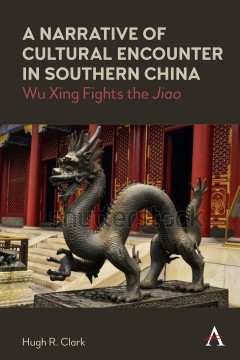A Narrative of Cultural Encounter in Southern China
Wu Xing Fights the 'Jiao'
By Hugh R. Clark
Other Formats Available:
- About This Book
- Reviews
- Author Information
- Series
- Table of Contents
- Links
- Podcasts
About This Book
For millennia the proto-Chinese Sinitic cultures of the Yellow River basin, centered on the Central (or “North China”) Plain, evolved in a very different direction from those of the Yangtze basin and lands to the farther south. Because scholars of the former monopolized the written record, East Asian history has long adopted their viewpoint, which has discounted the importance of those southern cultures, which were dismissed as “barbaric.”
This book uses the drainage and reclamation of a coastal marsh on the central Fujian coast organized by a Sinitic magnate in the later eighth century to explore both the nature of local culture and its interaction with and impact upon the evolving Sinitic culture. Bearers of the latter had already been migrating toward the south for centuries, but before the Tang few had ventured south of the Min River basin in northern Fujian into the central and southern basins of the province. The project was undertaken in response to their growing demand for land, which grew as the pace of migration accelerated in the aftermath of the mid-eighth century rebellions that almost ended the Tang.
Later records claim that the project was undermined by a jiao, a mythological dragon-like beast. The author argues that this in fact was a crocodile that was wallowing in the dikes. Cultural memory had transformed the crocodile into a jiao as a representation of the indigenous culture that had transformed Sinitic culture. He concludes that this local event illustrates the accommodation that evolved between the classical culture of the Yellow River and the local cultures of the south.
Reviews
By absorbingly interlacing historical narrative with allegory, Hugh Clark informs us, as no previous author has, of the comprehensive scope and impactful southward expansion of the medieval Chinese civilization-building project. Clark’s book is a must-read for anyone seeking knowledge of the foundations of Chinese identity formation during this pivotal time.”—Don J. Wyatt, John M. McCardell,Jr. Distinguished Professor, Department of History,
Middlebury College, USA.
“Over the last forty years Hugh Clark has established himself as one of our most pre- eminent historians of South China. In this book he puts a lifetime of research into its most accessible form, expertly weaving together the larger history of China with a very particular story of immigration, coastal reclamation, cultural transformation, and deadly crocodiles"—Andrew Chittick, the E. Leslie Peter Professor of East Asian Humanities & History, Eckerd College, USA.
Hugh Clark brings decades of research on Medieval China’s history and culture to this intriguing study, which uses a legendary encounter between a Chinese official and a dragon to explore how the diverse regional and local cultures of South China were incorporated into the Chinese state.”— Terry Kleeman, Professor Emeritus of Chinese and Religious Studies, University of Colorado, Boulder, USA.
“The southern paddy fields of China are now considered integral to the modern country, but it was not always so, and the present state of affairs was not inevitable. Hugh Clark has written imaginative microhistory introducing a little-known world of crocodiles and mythical beasts, economic displacement and colonial expansion, the power of local deities and - possibly - cultural resistance"—Naomi Standen, Emeritus Professor of Medieval History, University of Birmingham, Associate Member of the History Faculty, University of Oxford, USA.
Professor Hugh R. Clark is a national- and internationally-recognized expert on Song dynasty (960-1279) history. His scholarly credentials are impeccable; his publication record is extraordinary. The tale of Wu Xing (eighth century) and his plight to save the Putian district from a malevolent kraken functions in this study as a backdrop to a much more important story: the centuries-long reclamation efforts in China to reclaim the coastal areas of the Putian Plain in modern Fujian province. I know of no China historian writing in English who can document and explain this process—using primary source materials—with more authority than Professor Hugh R. Clark"—James M. Hargett, The University of North Carolina-Charlotte, USA.
Clark has successfully demonstrated in a short and very readable work how the indigenous peoples of Fujian were not merely assimilated to the incoming culture but instead played a significant and vital role in its transformation, resulting in the creation of a local iteration of Sinitic culture that incorporated major elements of their own religious and cultural practices. Clark’s book is not merely commendable as a groundbreaking study on an understudied region, it also stands as a useful guide for other scholars who might wish to conduct research on how indigenous encounters played out elsewhere south of the Yangtze— Journal of Chinese History.
Author Information
Hugh R. Clark was a member of the history and East Asian studies programs at Ursinus College (Pennsylvania) for 35 years. He is now retired from active teaching.
Series
Anthem Impact
Table of Contents
Relevant Dynastic Timeline; Preface; 1. Introduction to a Problem; 2. The Story; 3. Some Background; 4. The Sinitic Encounter and Wu Xing; 5. The Song Consolidation and Sinitic Accommodation; 6. The Ecological and Environmental Consequences; 7. Conclusions; Suggestions for Further Reading; Index
Links
Stay Updated
Information
Latest Tweets



